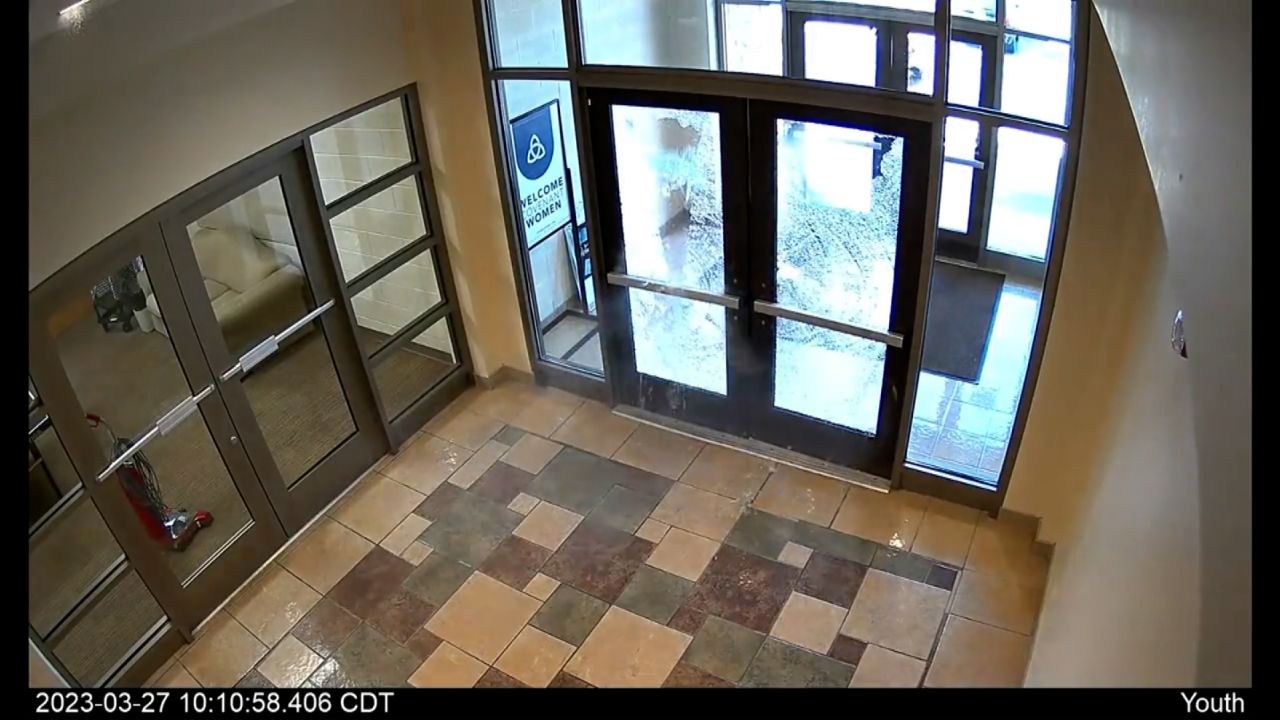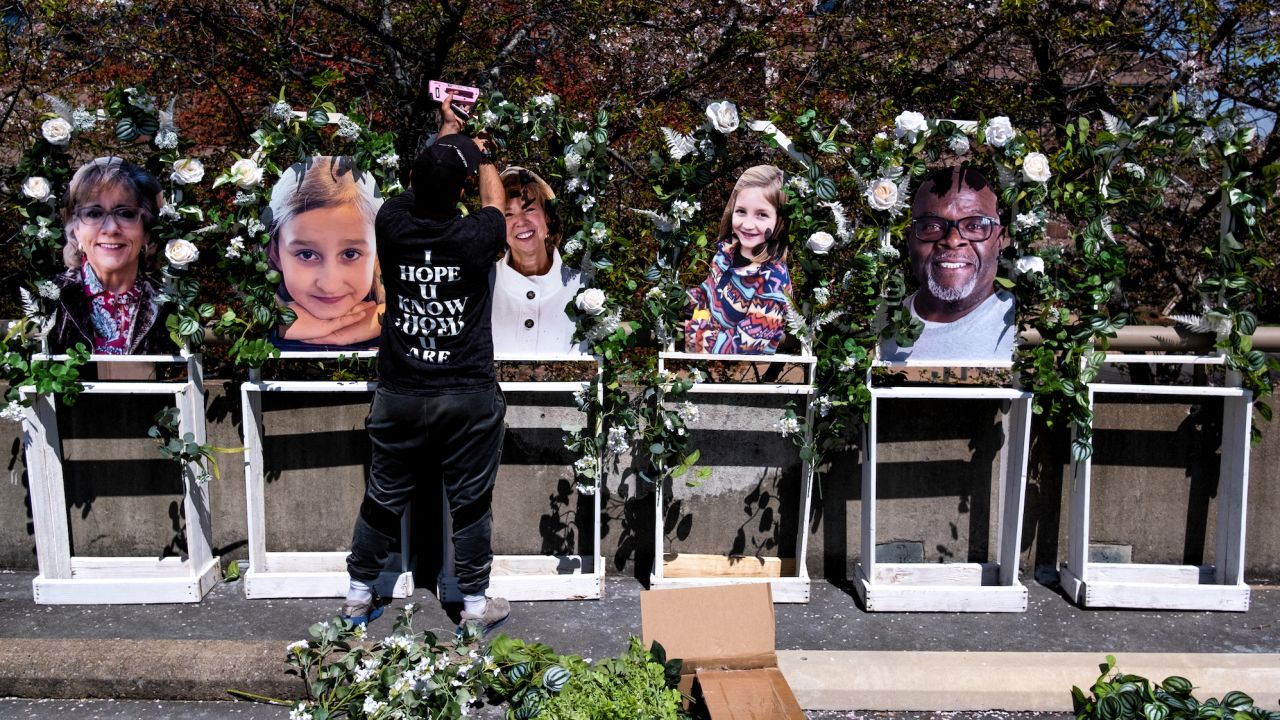CNN
—
Semiautomatic gunfire echoed in the hallways of The Covenant School, making a distinct noise teachers there would not soon forget.
That was more than 14 months ago – before three children and three adults were gunned down on Monday in the stately stone school connected to Covenant Presbyterian Church, atop a tree-shrouded hill just south of downtown Nashville.
The active shooter training session ended with live gunfire intended to familiarize school staff with real gunshots if they ever heard them.
“Blanks don’t sound the same. They just don’t,” said security consultant Brink Fidler, whose firm conducted the exercise.
A bullet trap the trainers wheeled around captured the rounds of a semiautomatic pistol and an AR-15-style rifle loaded with real ammunition.
When a handful of teachers heard the very first shot of Monday’s rampage they initially mistook it for the din of ongoing construction at the building.
“But then they said, ‘When we heard a few more after that we all knew because we had heard it before,” said Fidler, a former police officer who did a walk-through of the elementary school with Nashville officials on Wednesday – two days after another massacre in America renewed questions about what schools are doing to protect children and staff against mass murder.
As investigators work to determine the motive for the carnage, students, parents and school leaders across the country are again asking what more can be done to secure schools in the era of active shooter drills, lockdowns and widespread anxiety amid recurring mass shootings.
Fortified school buildings and entrance doors, glass panes coated in bullet-resistant laminate, locked classrooms and heavy surveillance have became a part of life in places where children are supposed to feel inspired to learn.
A funeral service for Evelyn Dieckhaus, 9, the first victim to be laid to rest, was held Friday, which would have been the final school day before Easter break for the 200 or so private school students.
The shooter was a former Covenant School student, who also killed William Kinney and Hallie Scruggs, both 9; Katherine Koonce, the 60-year-old head of the school; Cynthia Peak, a 61-year-old substitute teacher; and Mike Hill, a 61-year-old custodian.
Police fatally shot the 28-year-old attacker – who was armed with an AR-15 military-style rifle, a 9 mm Kel-Tec SUB2000 pistol caliber carbine, and a 9 mm Smith and Wesson M&P Shield EZ 2.0 handgun – inside the school about 14 minutes after the shooter fired through locked glass doors to enter the building.
The AR-15 and 9 mm pistol caliber carbine appeared to have 30-round magazines, according to experts who reviewed photos and video released by police.
Officers were on scene at 10:24 a.m. and fatally shot the attacker three minutes later, police said.
“The shooter, confronted in the second floor lobby, didn’t even have a chance to get to the classrooms,” said CNN analyst Jennifer Mascia, a writer and founding staffer of The Trace, a non-profit focused on gun violence. “That is something that is very reassuring to parents across the country. However, as we see, even a robust police response is not enough.”
The attack was the 19th shooting at an American school or university in 2023 in which at least one person was wounded, according to a CNN count. It was the deadliest since the May attack in Uvalde, Texas, left 21 dead. There have been 42 K-12 school shootings since Uvalde, where the gunman fired 100 or so rounds before police breached a classroom more than an hour later and killed the attacker to end the siege.
Once again, children, their parents and school leaders are left struggling with how to stop and handle mass shootings even though such incidents are rare and schools are still quite safe.
“What a lot of school leaders have learned is don’t react quickly. You’ve got a lot of pressure to do something right away but it’s really better to be thoughtful,” said Michael Dorn, executive director of Safe Havens International, a nonprofit school safety firm that has evaluated security at thousands of schools.
“You should assume that you don’t have a good picture of what really happened and what didn’t. Be very skeptical about claims that this saves lives or people died because of that. In Tennessee no one will have a really accurate picture of what happened there for months.”
Coping with the nightmare scenario of a school shooting is now part of the mission to educate and counsel children.
It’s been 24 years since the Columbine High School mass shooting left 13 people dead in 1999. And more than a decade since a gunman shot his way through glass at the Sandy Hook Elementary School in Newtown, Connecticut, and killed six adults and 20 children.
“We keep repeating the same mistakes because people don’t know what the same mistakes are,” Fidler said. “School resource officers are a great part of the solution. Security laminate – great part of the solution. Cameras – great part of the solution. But if the people in the building don’t know what to do, none of that other stuff means anything.”

Mass shootings have helped fuel a multibillion dollar school security industry in recent years – ranging from high-tech surveillance systems to weapon scanners and hand-held emergency panic devices to immediately alert law enforcement and lock down schools.
“The message is really simple and it has been since before Nashville,” said Ken Trump, president of National School Safety and Security Services, who was scheduled to speak about school security this weekend at the annual conference of the National School Boards Association in Orlando, Florida. “One of the worst times to make knee jerk policy and administrative actions is after a high profile incident like this when you’re in a highly emotional state.”
Experts said school officials should not give in to political pressures to take steps that are likely to be ineffective and wasteful of limited resources.
“We’ve been in schools where, on the positive side, almost every staff member has a two-way walkie talkie, which is good,” Trump said. “And we’ve been in other schools, sometimes in the same district, where they’re sitting in a charger and the principal says, ‘Well, we have them but I prefer to not use them.’ “
He added, “When security works, it works because of people. When it fails, it fails because of people.”
Dorn said he has been inundated with emails since Monday from companies “I’ve never heard of,” with offers of technology they claim will heighten security in schools.
“The three things that every school leader better pay a lot of attention to is, we have limited time, energy and budget for safety,” Dorn said. “So we can’t afford to waste any of that. We can’t spend our budget or training time on something that we don’t have pretty good evidence actually bears fruit. With the caution that nothing’s going to be 100 percent. This idea that we’re gonna stop all school shootings; there’s just, no country has been able to do that.”
Dorn and others pointed to a 2016 school safety technology report from Johns Hopkins University that found there was insufficient evidence to show devices such as weapons detectors and high-tech alarms and sensors helped curb mass shootings.
“There is no universal school safety solution – no one technology will solve all school safety and security issues,” the researchers wrote. “The sheer number of schools and school districts across the country – with different geography, funding, building construction and layout, demographics, and priorities – make each one different.”

Fidler and others said more resources should be devoted to educating and training students and school staff on recognizing and responding to threats.
“I can’t tell you how many of our school clients still have classroom doors that are not lockable from inside the classroom,” he said.
Referring to training and preparation for catastrophic school events like a mass shooting, Fidler said: “As a society we suck at this – which is terrible, but we do.”
On Wednesday, two days after the massacre, Fidler did a walk-through of the blood-stained school corridors with investigators. “It was hard, man. I’m struggling,” the law enforcement veteran of nearly 20 years said Saturday. “Some of that blood belonged to people I know.”
Fidler found that upon recognizing they were under attack teachers and staff relied on their training.
The shooter fired multiple rounds into several classroom doors but didn’t hit any students inside “because the teachers knew exactly what to do, how to fortify their doors and where to place their children in those rooms,” Fidler said.
“Their ability to execute, literally flawlessly, under that amount of stress while somebody is trying to murder them and their children, that is what made the difference here,” he said.
“These teachers are the reason those kids went home to their families.”
Koonce, the head of the school, had been adamant about training school staff on how to respond during an active shooter situation, Fidler said.
“She understood the severity of the topic and the severity of the teachers needing to have the knowledge of what to do in that situation,” he said.
“Katherine went to find out what was happening” when she was shot, Fidler said. “You know, Katherine Koonce, I could have had a lasso around her waist and she would drag me down the hall. She was going to go find out what’s going on and try and figure out what’s best for her students… She went right to it.”
Metro Nashville Police Chief John Drake could not confirm how Koonce died but said, “I do know she was in the hallway by herself. There was a confrontation, I’m sure. You can tell the way she is lying in the hallway.”
Fidler said teachers covered windows. They shut off lights. Unused medical kits sat on desks.
“Countless teachers had their bleeding control kits out, staged and ready to treat people in their classroom,” he recalled.
“The fact that they had the wherewithal to do that. ‘Ok, I’ve got my kids secure. I’ve got the door locked and barricaded.’ And now, as a teacher, to have the wherewithal to remember the last piece, the medical, because we can potentially save a lot of people. They crushed it. They were able to perform under that amount of stress… They were able to recall all this information and put it into practice.”
The six shooting victims were trapped in hallways and killed, Fidler said.
“How many teachers in America could walk into their classroom right now and throw a tourniquet on the table and put that on? How many of them could do it?”
His message for anxious parents: “Ask questions. Find out what your kids’ school is doing or not doing. And don’t stop asking until something’s done.”